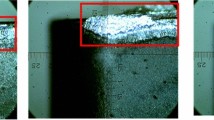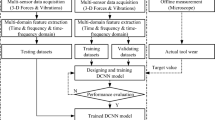Abstract
An accurate prediction of the machining tool condition during the cutting process is crucial for enhancing the tool life, improving the production quality and productivity, optimizing the labor and maintenance costs, and reducing workplace accidents. Currently, tool condition monitoring is usually based on machine learning algorithms, especially deep learning algorithms, to establish the relationship between sensor signals and tool wear. However, deep mining of feature and fusion information of multi-sensor signals, which are strongly related to the tool wear, is a critical challenge. To address this issue, in this study, an integrated prediction scheme is proposed based on deep learning algorithms. The scheme first extracts the local features of a single sequence and a multi-dimensional sequence from DenseNet incorporating a heterogeneous asymmetric convolution kernel. To obtain more perceptual historical data, a “dilation” scheme is used to extract features from a single sequence, and one-dimensional dilated convolution kernels with different dilation rates are utilized to obtain the differential features. At the same time, asymmetric one-dimensional and two-dimensional convolution kernels are employed to extract the features of the multi-dimensional signal. Ultimately, all the features are fused. Then, the time-series features hidden in the sequence are extracted by establishing a depth-gated recurrent unit. Finally, the extracted in-depth features are fed to the deep fully connected layer to achieve the mapping between features and tool wear values through linear regression. The results indicate that the average errors of the proposed model are less than 8%, and this model outperforms the other tool wear prediction models in terms of both accuracy and generalization.

















Similar content being viewed by others
References
Aghazadeh, F., Tahan, A., & Thomas, M. (2018). Tool condition monitoring using spectral subtraction and convolutional neural networks in milling process. The International Journal of Advanced Manufacturing Technology, 98(9), 3317–3227.
Alireza, B., Martin, M., David, S., Henrik, M., Muratoglu, O. K., & Varadarajan, K. M. (2020). Natural language processing with deep learning for medical adverse event detection from free-text medical narratives: A case study of detecting total hip replacement dislocation. Computers in Biology and Medicine, 129, 104140. https://doi.org/10.1016/j.compbiomed.2020.104140
An, Q., Tao, Z., Xu, X., Mansori, M. E., & Chen, M. (2020). A data-driven model for milling tool remaining useful life prediction with convolutional and stacked LSTM network. Measurement, 154, 107461.
Cai, W., Zhang, W., Hu, X., & Liu, Y. (2020). A hybrid information model based on long short-term memory network for tool condition monitoring. Journal of Intelligent Manufacturing. https://doi.org/10.1007/s10845-019-01526-4
Cao, X.-C., Chen, B.-Q., Yao, B., & He, W.-P. (2019). Combining translation-invariant wavelet frames and convolutional neural network for intelligent tool wear state identification. Computers in Industry, 106, 71–84. https://doi.org/10.1016/j.compind.2018.12.018
Chadha, G. S., Panara, U., Schwung, A., & Ding, S. X. (2021). Generalized dilation convolutional neural networks for remaining useful lifetime estimation. Neurocomputing, 452, 182–199.
Chen, Y., Jin, Y., & Jiri, G. (2018). Predicting tool wear with multi-sensor data using deep belief networks. The International Journal of Advanced Manufacturing Technology, 99(5), 1917. https://doi.org/10.1007/s00170-018-2571-z
Cho, K., Van Merrienboer, B., Gulcehre, C., Bahdanau, D., Bougares, F., Schwenk, H., et al. (2014). Learning phrase representations using RNN encoder–decoder for statistical machine translation. Computer Science. https://doi.org/10.3115/v1/D14-1179
Choudhary, M., Tiwari, V., & Venkanna, U. (2019). An approach for iris contact lens detection and classification using ensemble of customized DenseNet and SVM. Future Generation Computer Systems, 101, 1259–1270. https://doi.org/10.1016/j.future.2019.07.003
Cooper, C., Wang, P., Zhang, J., Gao, R. X., Roney, T., Ragai, I., et al. (2020). Convolutional neural network-based tool condition monitoring in vertical milling operations using acoustic signals. Procedia Manufacturing, 49(C), 105–111. https://doi.org/10.1016/j.promfg.2020.07.004
Dokuz, Y., & Tufekci, Z. (2021). Mini-batch sample selection strategies for deep learning based speech recognition. Applied Acoustics, 171, 107573. https://doi.org/10.1016/j.apacoust.2020.107573
Ezugwu, E. O., & Wang, Z. M. (1997). Titanium alloys and their machinability—a review. Journal of Materials Processing Technology, 68(3), 262–274.
He, K., Zhang, X., Ren, S., & Sun, J. (2016). Deep residual learning for image recognition. In IEEE conference on computer vision & pattern recognition. https://doi.org/10.1109/CVPR.2016.90
Hochreiter, S., & Schmidhuber, J. (1997). Long short-term memory. Neural Computation, 9(8), 1735–1780. https://doi.org/10.1162/neco.1997.9.8.1735
Hochreiter, S. (1998). The vanishing gradient problem during learning recurrent neural nets and problem solutions. International Journal of Uncertainty, Fuzziness and Knowledge-Based Systems, 6(2), 107–116. https://doi.org/10.1142/S0218488598000094
Huang, G., Liu, Z., Laurens, V. D. M., & Weinberger, K. Q. (2016). Densely connected convolutional networks. https://doi.org/10.1109/CVPR.2017.243.
Huang, Z., Zhu, J., Lei, J., Li, X., & Tian, F. (2019). Tool wear predicting based on multi-domain feature fusion by deep convolutional neural network in milling operations. Journal of Intelligent Manufacturing. https://doi.org/10.1007/s10845-019-01488-7
Huibin, S., Jiduo, Z., Rong, M., & Xianzhi, Z. (2019). In-process tool condition forecasting based on a deep learning method. Robotics and Computer-Integrated Manufacturing, 64, 101924. https://doi.org/10.1016/j.rcim.2019.101924
Jaini, S. N. B., Lee, D.-W., Lee, S.-J., Kim, M.-R., & Son, G.-H. (2020). Indirect tool monitoring in drilling based on gap sensor signal and multilayer perceptron feed forward neural network. Journal of Intelligent Manufacturing. https://doi.org/10.1007/s10845-020-01635-5
Jurkovic, Z., Cukor, G., Brezocnik, M., & Brajkovic, T. (2018). A comparison of machine learning methods for cutting parameters prediction in high speed turning process. Journal of Intelligent Manufacturing. https://doi.org/10.1007/s10845-016-1206-1
Karomati, B. D., Hsing, C. C., & Lihui, W. (2020). Systematic literature review on augmented reality in smart manufacturing: Collaboration between human and computational intelligence. Journal of Manufacturing Systems. https://doi.org/10.1016/J.JMSY.2020.10.017
Kingma, D. P., & Ba, J. (2014). Adam: A method for stochastic optimization. arXiv:1412.6980.
Li, B., Zhang, P., Liang, S., & Ren, G. (2008). Feature extraction and selection for fault diagnosis of gear using wavelet entropy and mutual information. In 2008 9th international conference on signal processing.
Li, W., & Liu, T. (2019). Time varying and condition adaptive hidden Markov model for tool wear state estimation and remaining useful life prediction in micro-milling. Mechanical Systems and Signal Processing, 131, 689–702. https://doi.org/10.1016/j.ymssp.2019.06.021
Liu, C., & Zhu, L. (2020). A two-stage approach for predicting the remaining useful life of tools using bidirectional long short-term memory. Measurement, 164, 108029. https://doi.org/10.1016/j.measurement.2020.108029
Liu, S., Jiang, H., Wu, Z., & Li, X. (2021). Rolling bearing fault diagnosis using variational autoencoding generative adversarial networks with deep regret analysis. Measurement, 168, 108371. https://doi.org/10.1016/j.measurement.2020.108371
Mohanraj, T., Shankar, S., Rajasekar, R., Sakthivel, N. R., & Pramanik, A. (2020). Tool condition monitoring techniques in milling process—A review. Journal of Materials Research and Technology, 9(1), 1032–1042. https://doi.org/10.1016/j.jmrt.2019.10.031
Oord, A., Dieleman, S., Zen, H., Simonyan, K., & Kavukcuoglu, K. (2016). WaveNet: A generative model for raw audio.
Peltier, R. E., & Buckley, T. J. (2020). Sensor technology: A critical cutting edge of exposure science. Journal of Exposure Science & Environmental Epidemiology, 30(6), 901–902. https://doi.org/10.1038/s41370-020-00268-3
Pin, W., En, F., & Peng, W. (2021). Comparative analysis of image classification algorithms based on traditional machine learning and deep learning. Pattern Recognition Letters, 141, 61–67. https://doi.org/10.1016/J.PATREC.2020.07.042
Qiao, Q., Wang, J., Ye, L., & Gao, R. X. (2019). Digital twin for machining tool condition prediction. Procedia CIRP, 81, 1388–1393. https://doi.org/10.1016/j.procir.2019.04.049
Qu, D., Zheng, W., Wang, B., Wu, B., & Yi, H. (2020). Nondestructive acquisition of the micro-mechanical properties of high-speed-dry milled micro-thin walled structures based on surface traits. Chinese Journal of Aeronautics, 34, 438–451.
Rousseaux, F. (2017). BIG DATA and data-driven intelligent predictive algorithms to support creativity in industrial engineering. Computers & Industrial Engineering, 112, 459–465. https://doi.org/10.1016/j.cie.2016.11.005
Skordilis, E., & Moghaddass, R. (2020). A deep reinforcement learning approach for real-time sensor-driven decision making and predictive analytics. Computers & Industrial Engineering, 147, 106600. https://doi.org/10.1016/j.cie.2020.106600
Szegedy, C., Liu, W., Jia, Y., Sermanet, P., & Rabinovich, A. (2014). Going deeper with convolutions. IEEE Computer Society.
Tiwari, K., Shaik, A., & Arunachalam, N. (2018). Tool wear prediction in end milling of Ti–6Al–4V through Kalman filter based fusion of texture features and cutting forces. Procedia Manufacturing, 26, 1459–1470. https://doi.org/10.1016/j.promfg.2018.07.095
Wang, J., Yan, J., Li, C., Gao, R. X., & Zhao, R. (2019). Deep heterogeneous GRU model for predictive analytics in smart manufacturing: Application to tool wear prediction. Computers in Industry, 111, 1–14. https://doi.org/10.1016/j.compind.2019.06.001
Xia, M., Zheng, X., Imran, M., & Shoaib, M. (2020). Data-driven prognosis method using hybrid deep recurrent neural network. Applied Soft Computing Journal, 93, 106351. https://doi.org/10.1016/j.asoc.2020.106351
XuTing, M., Feng, Z., Gang, W., Yan, C., & KaiFu, Y. (2020). Semi-random subspace with Bi-GRU: Fusing statistical and deep representation features for bearing fault diagnosis. Measurement. https://doi.org/10.1016/j.measurement.2020.108603
Yang, Y., Guo, Y., Huang, Z., Chen, N., Li, L., Jiang, Y., et al. (2019). Research on the milling tool wear and life prediction by establishing an integrated predictive model. Measurement, 145, 178–189. https://doi.org/10.1016/j.measurement.2019.05.009
Youdao, W., Sri, A., & Yifan, Z. (2020). Recurrent neural networks and its variants in remaining useful life prediction. IFAC-PapersOnLine, 53(3), 137–142. https://doi.org/10.1016/J.IFACOL.2020.11.022
Yu, F., & Koltun, V. (2016). Multi-scale context aggregation by dilated convolutions. In ICLR.
Yu, W., Kim, I. Y., & Mechefske, C. (2020). An improved similarity-based prognostic algorithm for RUL estimation using an RNN autoencoder scheme. Reliability Engineering and System Safety, 199, 106926. https://doi.org/10.1016/j.ress.2020.106926
Zhang, K. F., Yuan, H. Q., & Nie, P. (2015). A method for tool condition monitoring based on sensor fusion. Journal of Intelligent Manufacturing, 26(5), 1–16.
Zhou, Y., & Xue, W. (2018). Review of tool condition monitoring methods in milling processes. The International Journal of Advanced Manufacturing Technology. https://doi.org/10.1007/s00170-018-1768-5
Acknowledgements
This research was funded by Projects of International Cooperation and Exchanges NSFC (Grant Numbers 51720105009). National Key Research and Development Project (Grant Numbers 2019YFB1704800). Outstanding Youth Fund of Heilongjiang Province (Grant Numbers YQ2019E029).
Author information
Authors and Affiliations
Corresponding author
Ethics declarations
Conflict of interest
The authors declare that they have no conflict of interest.
Additional information
Publisher's Note
Springer Nature remains neutral with regard to jurisdictional claims in published maps and institutional affiliations.
Rights and permissions
About this article
Cite this article
Liu, X., Zhang, B., Li, X. et al. An approach for tool wear prediction using customized DenseNet and GRU integrated model based on multi-sensor feature fusion. J Intell Manuf 34, 885–902 (2023). https://doi.org/10.1007/s10845-022-01954-9
Received:
Accepted:
Published:
Issue Date:
DOI: https://doi.org/10.1007/s10845-022-01954-9




